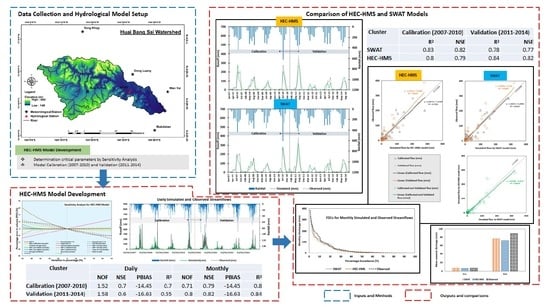Comparison of Two Hydrological Models, HEC-HMS and SWAT in Runoff Estimation: Application to Huai Bang Sai Tropical Watershed, Thailand
Abstract
:1. Introduction
2. The Study Area and Data Required
3. Rainfall–Runoff Modelling of the HBS Watershed
4. Development of Hydrologic Models
4.1. SWAT Model Development
4.2. HEC-HMS Model Development
5. Results and Discussion
5.1. Results from the HEC-HMS Model
5.2. Streamflow Prediction Capacities between the HEC-HMS and SWAT Models
6. Conclusions
Author Contributions
Funding
Institutional Review Board Statement
Informed Consent Statement
Data Availability Statement
Acknowledgments
Conflicts of Interest
References
- Gunathilake, M.B.; Amaratunga, Y.V.; Perera, A.; Chathuranika, I.M.; Gunathilake, A.S.; Rathnayake, U. Evaluation of Future Climate and Potential Impact on Streamflow in the Upper Nan River Basin of Northern Thailand. Adv. Meteorol. 2020, 2020, 8881118. [Google Scholar] [CrossRef]
- Li, T.; Duan, Y.; Guo, S.; Meng, L.; Nametso, M. Study on Applicability of Distributed Hydrological Model under Different Terrain Conditions. Sustainability 2020, 12, 9684. [Google Scholar] [CrossRef]
- Flores, N.; Rodríguez, R.; Yépez, S.; Osores, V.; Rau, P.; Rivera, D.; Balocchi, F. Comparison of Three Daily Rainfall-Runoff Hydrological Models Using Four Evapotranspiration Models in Four Small Forested Watersheds with Different Land Cover in South-Central Chile. Water 2021, 13, 3191. [Google Scholar] [CrossRef]
- Gunathilake, M.B.; Panditharathne, P.; Gunathilake, A.S.; Warakagoda, N. Application of a HEC-HMS model on event-based simulations in a tropical watershed. Eng. Appl. Sci. Res. 2020, 47, 349–360. [Google Scholar]
- Yang, S.-C.; Yang, T.-H.; Chang, Y.-C.; Chen, C.-H.; Lin, M.-Y.; Ho, J.-Y.; Lee, K.T. Development of a Hydrological Ensemble Prediction System to Assist with Decision-Making for Floods during Typhoons. Sustainability 2020, 12, 4258. [Google Scholar] [CrossRef]
- Hanif, A.; Dhanasekar, A.; Keene, A.; Li, H.; Carlson, K. Flood risk assessment methodology for planning under climate change scenarios and the corresponding change in land cover. J. Water Clim. Chang. 2019, 11, 1370–1382. [Google Scholar] [CrossRef]
- Bhatta, B.; Shrestha, S.; Shrestha, P.K.; Talchabhadel, R. Evaluation and application of a SWAT model to assess the climate change impact on the hydrology of the Himalayan River Basin. CATENA 2019, 181, 104082. [Google Scholar] [CrossRef]
- Chen, Q.; Chen, H.; Wang, J.; Zhao, Y.; Chen, J.; Xu, C. Impacts of Climate Change and Land-Use Change on Hydrological Extremes in the Jinsha River Basin. Water 2019, 11, 1398. [Google Scholar] [CrossRef] [Green Version]
- Zhou, Y.; Cui, Z.; Lin, K.; Sheng, S.; Chen, H.; Guo, S.; Xu, C.-Y. Short-term flood probability density forecasting using a conceptual hydrological model with machine learning techniques. J. Hydrol. 2021, 604, 127255. [Google Scholar] [CrossRef]
- Mvandaba, V.; Hughes, D.; Kapangaziwiri, E.; Kahinda, J.M.; Hobbs, P.; Madonsela, S.; Oosthuizen, N. The delineation of alluvial aquifers towards a better understanding of channel transmission losses in the Limpopo River Basin. Phys. Chem. Earth Parts A/B/C 2018, 108, 60–73. [Google Scholar] [CrossRef]
- Aureli, F.; Mignosa, P.; Prost, F.; Dazzi, S. Hydrological and Hydraulic Flood Hazard Modeling in Poorly Gauged Catchments: An Analysis in Northern Italy. Hydrology 2021, 8, 149. [Google Scholar] [CrossRef]
- Peng, H.; Jia, Y.; Tague, C.; Slaughter, P. An Eco-Hydrological Model-Based Assessment of the Impacts of Soil and Water Conservation Management in the Jinghe River Basin, China. Water 2015, 7, 6301–6320. [Google Scholar] [CrossRef] [Green Version]
- Arnold, J.G.; Muttiah, R.S.; Williams, J.R. Large-area hydrologic modeling and assessment: Part I. J. American Water Resour. Assoc. 1998, 34, 73–89. [Google Scholar] [CrossRef]
- Feldman, A. Hydrological Modeling System HEC-HMS, Technical Reference Manual; Hydrologic Engineering Center HEC; US Army Corps of Engineers: Davis, CA, USA, 2020. [Google Scholar]
- Bergström, S. The HBV Model-Its Structure and Applications; Swedish Meteorological and Hydrological Institute: Norrköping, Sweden, 1992. [Google Scholar]
- Krause, P. Das hydrologische Modellsystem J2000-Beschreibung und Anwendung in großen Flußgebieten (No. PreJuSER-37462); Programmgruppe Systemforschung und Technologische Entwicklung: Jülich, Germany, 2001; ISBN 3-89336-283-5. [Google Scholar]
- Perrin, C.; Michel, C.; Andréassian, V. Improvement of a parsimonious model for streamflow simulation. J. Hydrol. 2003, 279, 275–289. [Google Scholar] [CrossRef]
- Bicknell, B.R.; Imhoff, J.C.; Kittle, J.L.; Donigian, A.S.; Johanson, R.C. Athens, Greece: Hydrological Simulation Program—FORTRAN; User’s Manual for Version 11; Rep. No. EPA/600/R-97/080; U.S. EPA: Washington, DC, USA, 1997. [Google Scholar]
- Abbott, M.B.; Bathurst, J.C.; Cunge, J.A.; O’Connell, P.E.; Rasmussen, J. An introduction to the European Hydro-logical System-Système Hydrologique Européen, "SHE", 1: History and philosophy of a physically-based, distributed modelling system. J. Hydrol. 1986, 87, 45–59. [Google Scholar] [CrossRef]
- Đukić, V.; Erić, R. SHETRAN and HEC HMS Model Evaluation for Runoff and Soil Moisture Simulation in the Jičinka River Catchment (Czech Republic). Water 2021, 13, 872. [Google Scholar] [CrossRef]
- Babel, M.S.; Gunathilake, M.B.; Jha, M.K. Evaluation of Ecosystem-Based Adaptation Measures for Sediment Yield in a Tropical Watershed in Thailand. Water 2021, 13, 2767. [Google Scholar] [CrossRef]
- Gunathilake, M.B.; Amaratunga, Y.V.; Perera, A.; Karunanayake, C.; Gunathilake, A.S.; Rathnayake, U. Statistical evaluation and hydrologic simulation capacity of different satellite-based precipitation products (SbPPs) in the Upper Nan River Basin, Northern Thailand. J. Hydrol. Reg. Stud. 2020, 32, 100743. [Google Scholar] [CrossRef]
- Fathy, I.; Negm, A.M.; El-Fiky, M.; Nassar, M.; Al-Sayed, E. Runoff hydrograph modeling for arid regions (Case study: Wadi Sudr-Sinai). Int. Water Technol. J. 2015, 5, 58–68. [Google Scholar]
- Gunathilake, M.B.; Karunanayake, C.; Gunathilake, A.S.; Marasingha, N.; Samarasinghe, J.T.; Bandara, I.M.; Rathnayake, U. Hydrological Models and Artificial Neural Networks (ANNs) to Simulate Streamflow in a Tropical Catchment of Sri Lanka. Appl. Comput. Intell. Soft Comput. 2021, 2021, 6683389. [Google Scholar] [CrossRef]
- Chathuranika, I.M.; Gunathilake, M.B.; Azamathulla, H.; Rathnayake, U. Evaluation of Future Streamflow in the Upper Part of the Nilwala River Basin (Sri Lanka) under Climate Change. Hydrology 2022, 9, 48. [Google Scholar] [CrossRef]
- Shekar, N.C.S.; Vinay, D.C. Performance of HEC-HMS and SWAT to simulate streamflow in the sub-humid tropical Hemavathi catchment. J. Water Clim. Chang. 2021, 12, 3005–3017. [Google Scholar] [CrossRef]
- Phomcha, P.; Wirojanagud, P.; Vangpaisal, T.; Thaveevouthti, T. Predicting sediment discharge in an agricultural watershed: A case study of the Lam Sonthi watershed, Thailand. Sci. Asia 2011, 37, 43–50. [Google Scholar] [CrossRef]
- Supakosol, J.; Boonrawd, K. Hydrologic evaluation and effects of climate change on the Nong Han Lake Basin, northeastern Thailand. J. Water Clim. Chang. 2019, 11, 992–1000. [Google Scholar] [CrossRef]
- Rossi, C.G.; Srinivasan, K.; Jirayoot, T.; Le Due, P.; Souvannabouth, N.B.; Gassman, P.W. Hydrologic evaluation of the lower mekong river basin with the soil and water assessment tool model. Int. Agric. Eng. J. 2009, 18, 13. [Google Scholar]
- Kuntiyawichai, K.; Sri-Amporn, W.; Wongsasri, S.; Chindaprasirt, P. Anticipating of Potential Climate and Land Use Change Impacts on Floods: A Case Study of the Lower Nam Phong River Basin. Water 2020, 12, 1158. [Google Scholar] [CrossRef] [Green Version]
- Aliye, M.A.; Aga, A.O.; Tadesse, T.; Yohannes, P. Evaluating the Performance of HEC-HMS and SWAT Hydrological Models in Simulating the Rainfall-Runoff Process for Data Scarce Region of Ethiopian Rift Valley Lake Basin. Open J. Mod. Hydrol. 2020, 10, 105–122. [Google Scholar] [CrossRef]
- Khoi, D.N. Comparison of the HEC-HMS and SWAT hydrological models in simulating the streamflow. J. Sci. Technol. 2016, 53, 189–195. [Google Scholar]
- Ismail, H.; Kamal, M.R.; Hin, L.S.; Abdullah, A.F. Performance of HEC-HMS and ArcSWAT models for assessing climate change impacts on streamflow at Bernam River Basin in Malaysia. Sci. Technol. 2020, 28, 1027–1048. [Google Scholar]
- Kheereemangkla, Y.; Shrestha, R.P.; Shrestha, S.; Jourdain, D. Modeling hydrologic responses to land management scenarios for the Chi River Sub-basin Part II, Northeast Thailand. Environ. Earth Sci. 2016, 75, 793. [Google Scholar] [CrossRef]
- Bekele, W.T.; Haile, A.T.; Rientjes, T. Impact of climate change on the streamflow of the Arjo-Didessa catchment under RCP scenarios. J. Water Clim. Chang. 2021, 12, 2325–2337. [Google Scholar] [CrossRef]
- Bhuiyan, H.A.K.M.; McNairn, H.; Powers, J.; Merzouki, A. Application of HEC-HMS in a Cold Region Watershed and Use of RADARSAT-2 Soil Moisture in Initializing the Model. Hydrology 2017, 4, 9. [Google Scholar] [CrossRef] [Green Version]
- Haque, S.; Ali, M.; Islam, A.K.M.S.; Khan, J.U. Changes in flow and sediment load of poorly gauged Brahmaputra river basin under an extreme climate scenario. J. Water Clim. Chang. 2020, 12, 937–954. [Google Scholar] [CrossRef]
- Hamdan, A.; Almuktar, S.; Scholz, M. Rainfall-Runoff Modeling Using the HEC-HMS Model for the Al-Adhaim River Catchment, Northern Iraq. Hydrology 2021, 8, 58. [Google Scholar] [CrossRef]
- Tassew, B.G.; Belete, M.A.; Miegel, K. Application of HEC-HMS Model for Flow Simulation in the Lake Tana Basin: The Case of Gilgel Abay Catchment, Upper Blue Nile Basin, Ethiopia. Hydrology 2019, 6, 21. [Google Scholar] [CrossRef] [Green Version]
- Ouédraogo, W.A.A.; Raude, J.M.; Gathenya, J.M. Continuous Modeling of the Mkurumudzi River Catchment in Kenya Using the HEC-HMS Conceptual Model: Calibration, Validation, Model Performance Evaluation and Sensitivity Analysis. Hydrology 2018, 5, 44. [Google Scholar] [CrossRef] [Green Version]
- Chiang, S.; Chang, C.-H.; Chen, W.-B. Comparison of Rainfall-Runoff Simulation between Support Vector Regression and HEC-HMS for a Rural Watershed in Taiwan. Water 2022, 14, 191. [Google Scholar] [CrossRef]
- Melesse, A.M.; McClain, M.; Wang, X.; Abira, M.; Mutayoba, W. Modeling the Impact of Land-Cover and Rainfall Regime Change Scenarios on the Flow of Mara River, Kenya. In Proceedings of the World Environmental and Water Resources Congress 2008, Honolulu, HI, USA, 12–16 May 2008; pp. 1–10. [Google Scholar] [CrossRef]
- Akoko, G.; Le, T.; Gomi, T.; Kato, T. A Review of SWAT Model Application in Africa. Water 2021, 13, 1313. [Google Scholar] [CrossRef]
- Pignotti, G.; Rathjens, H.; Cibin, R.; Chaubey, I.; Crawford, M. Comparative Analysis of HRU and Grid-Based SWAT Models. Water 2017, 9, 272. [Google Scholar] [CrossRef] [Green Version]
- Marahatta, S.; Devkota, L.; Aryal, D. Application of SWAT in Hydrological Simulation of Complex Mountainous River Basin (Part I: Model Development). Water 2021, 13, 1546. [Google Scholar] [CrossRef]
- Lacombe, G.; Trébuil, G.; Polthanee, A. Long-term change in rainfall distribution in Northeast Thailand: Will cropping systems be able to adapt? Cah. Agric. 2017, 26, 25001. [Google Scholar] [CrossRef] [Green Version]
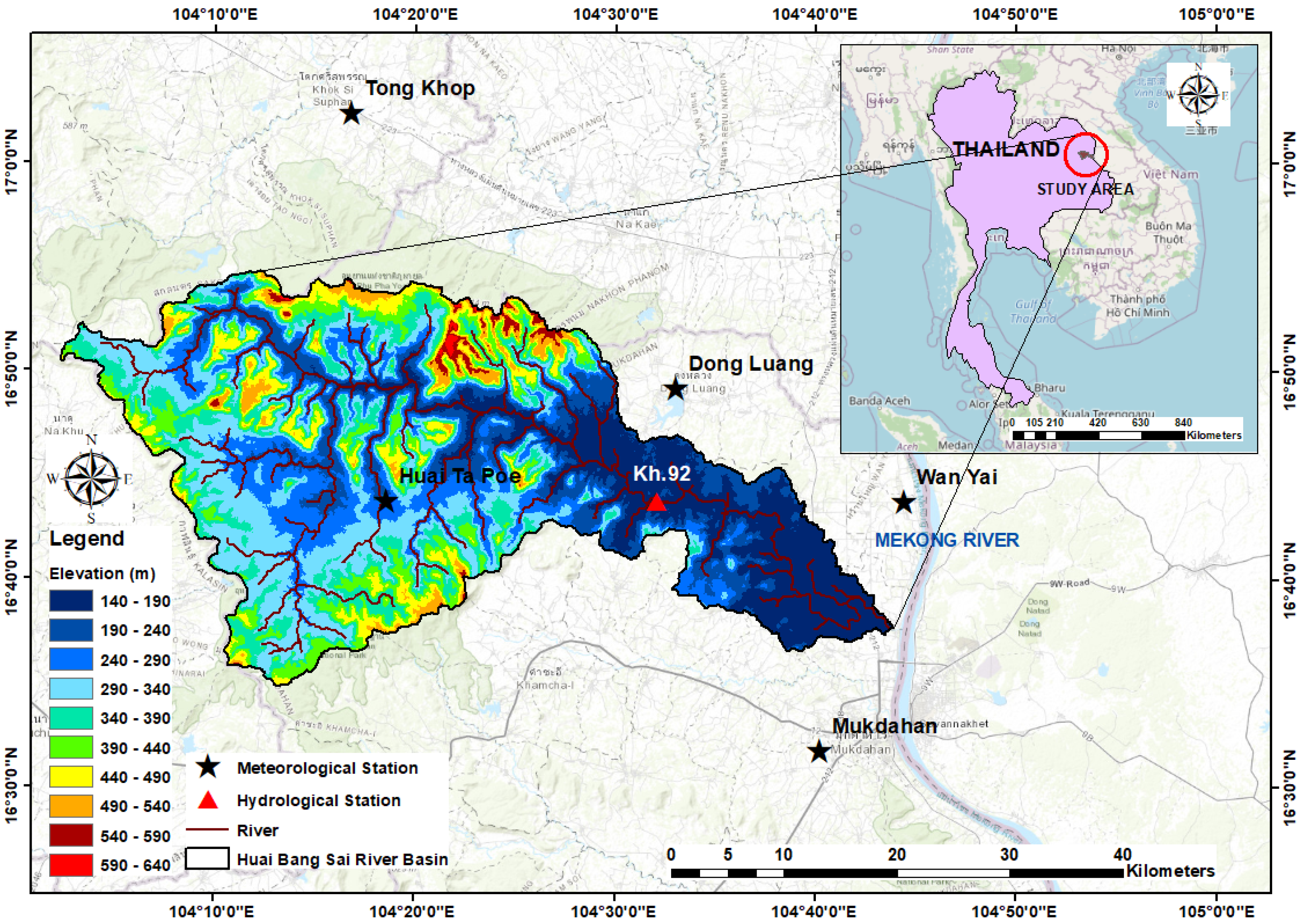

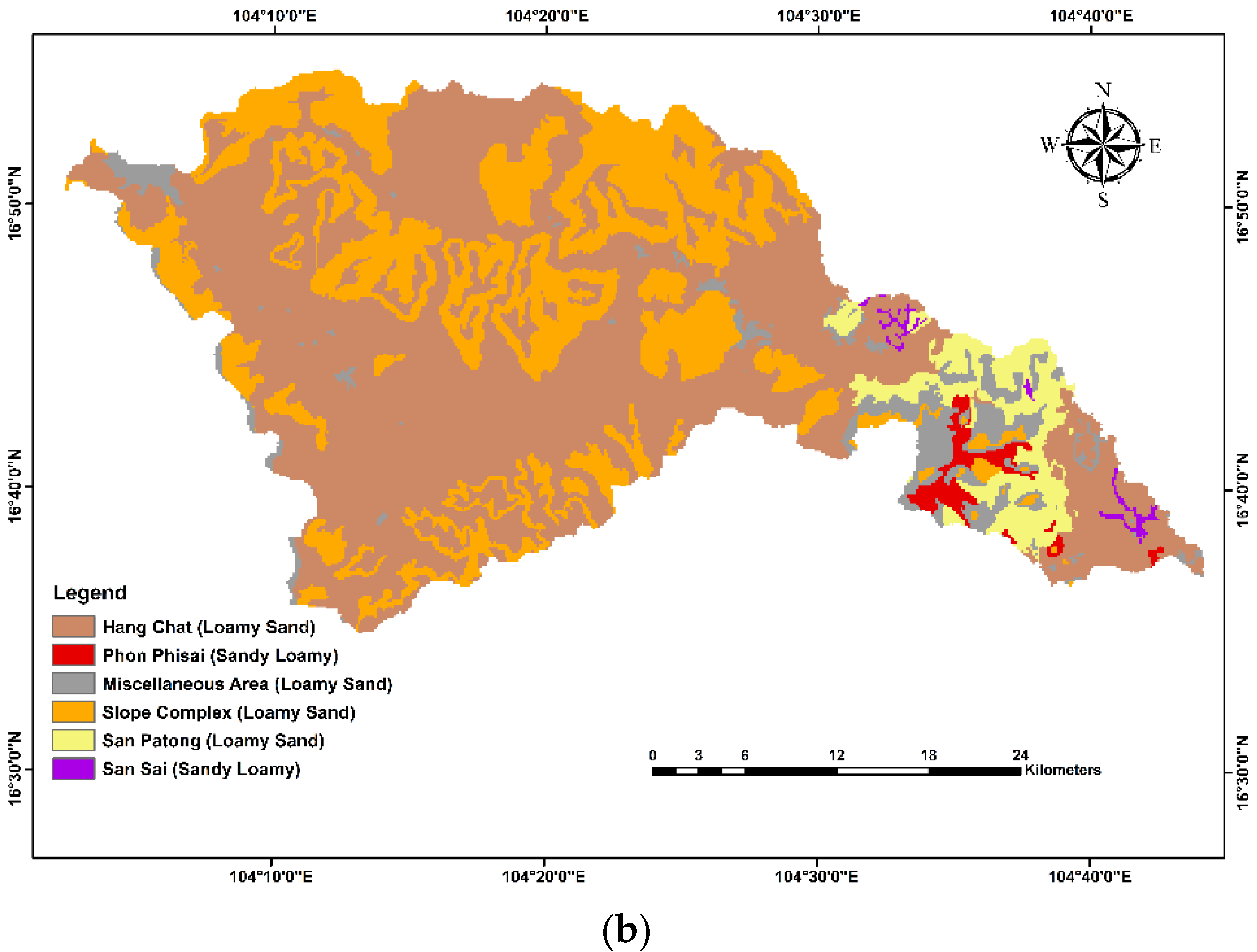
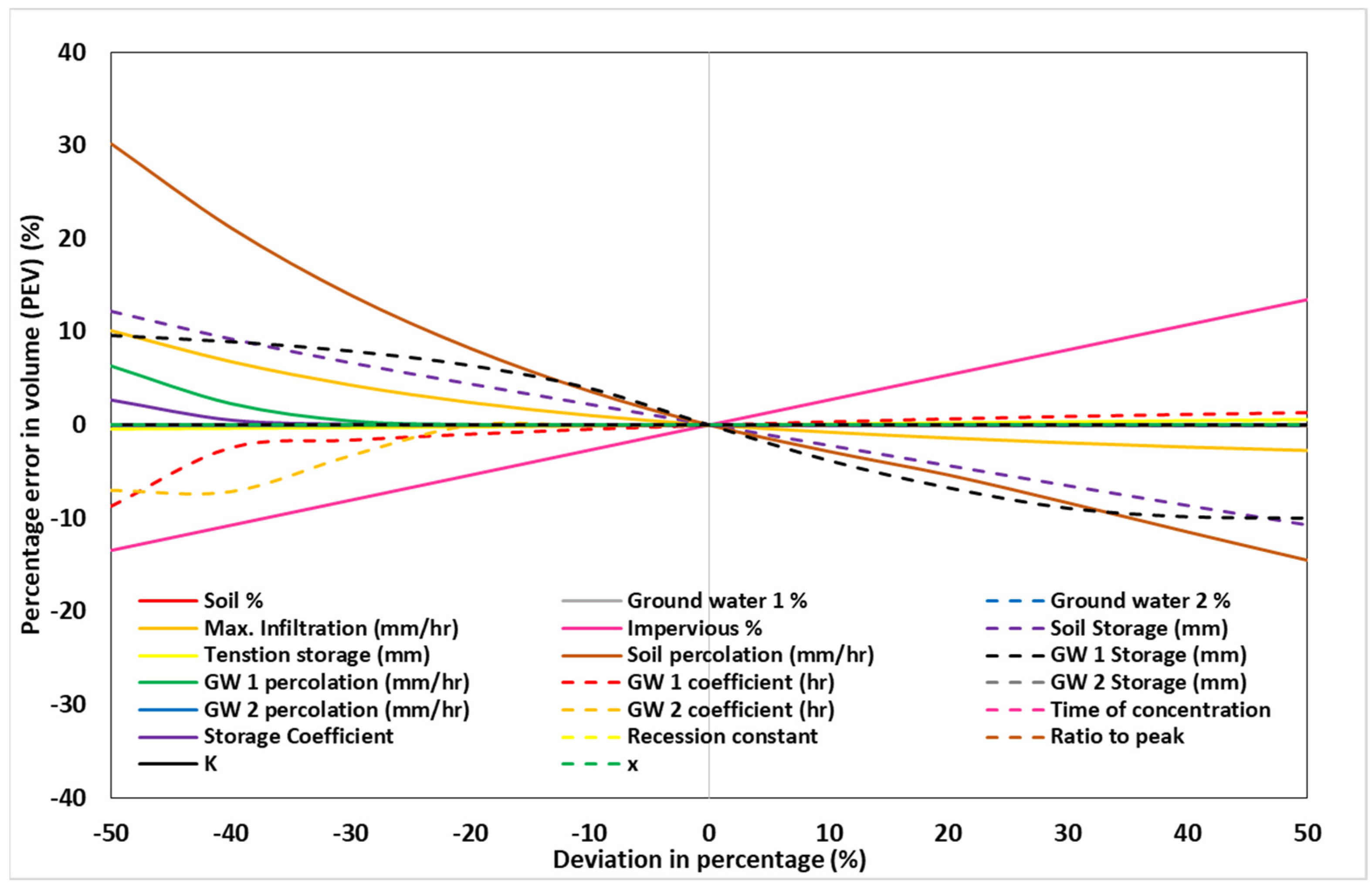

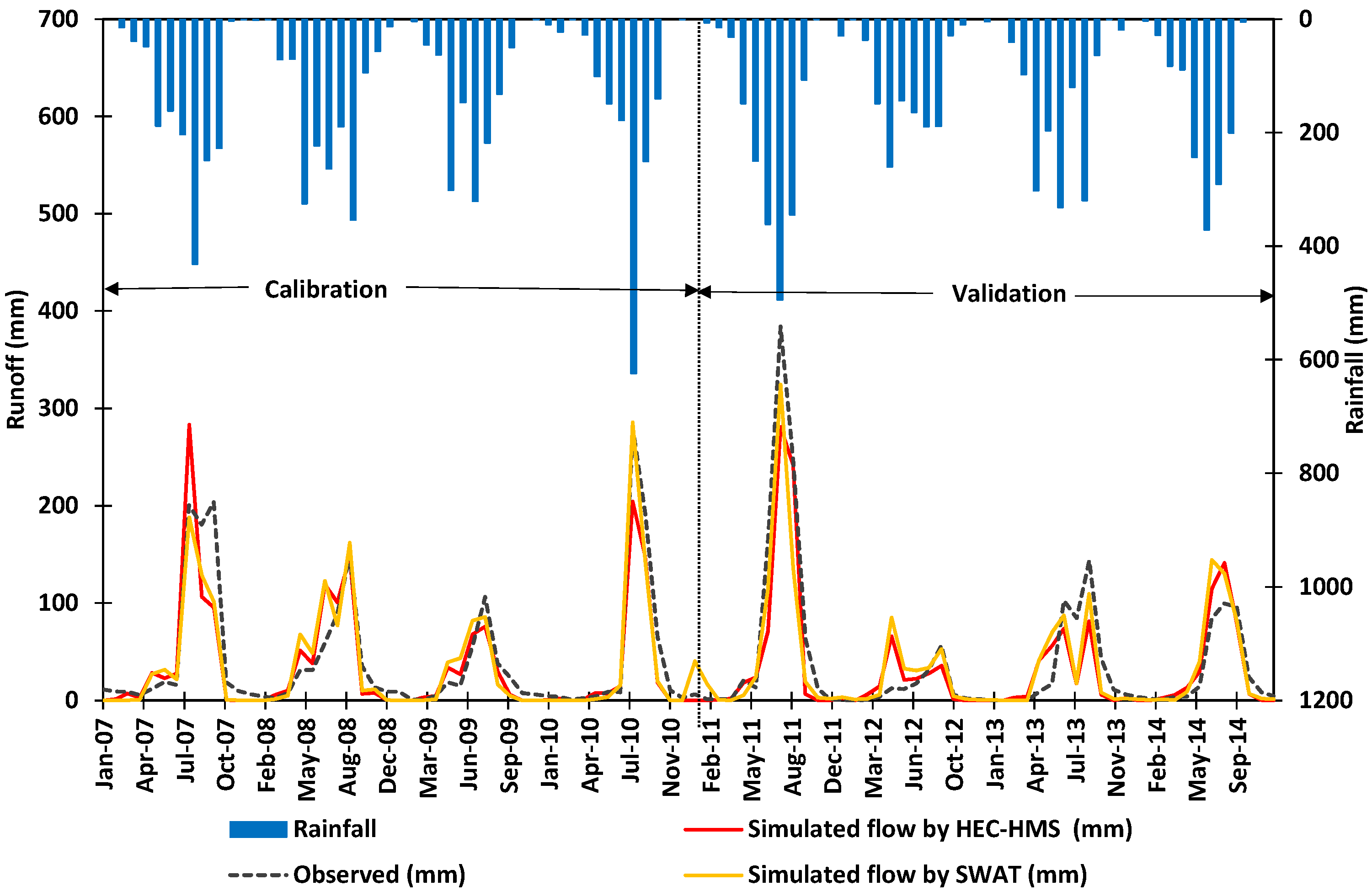

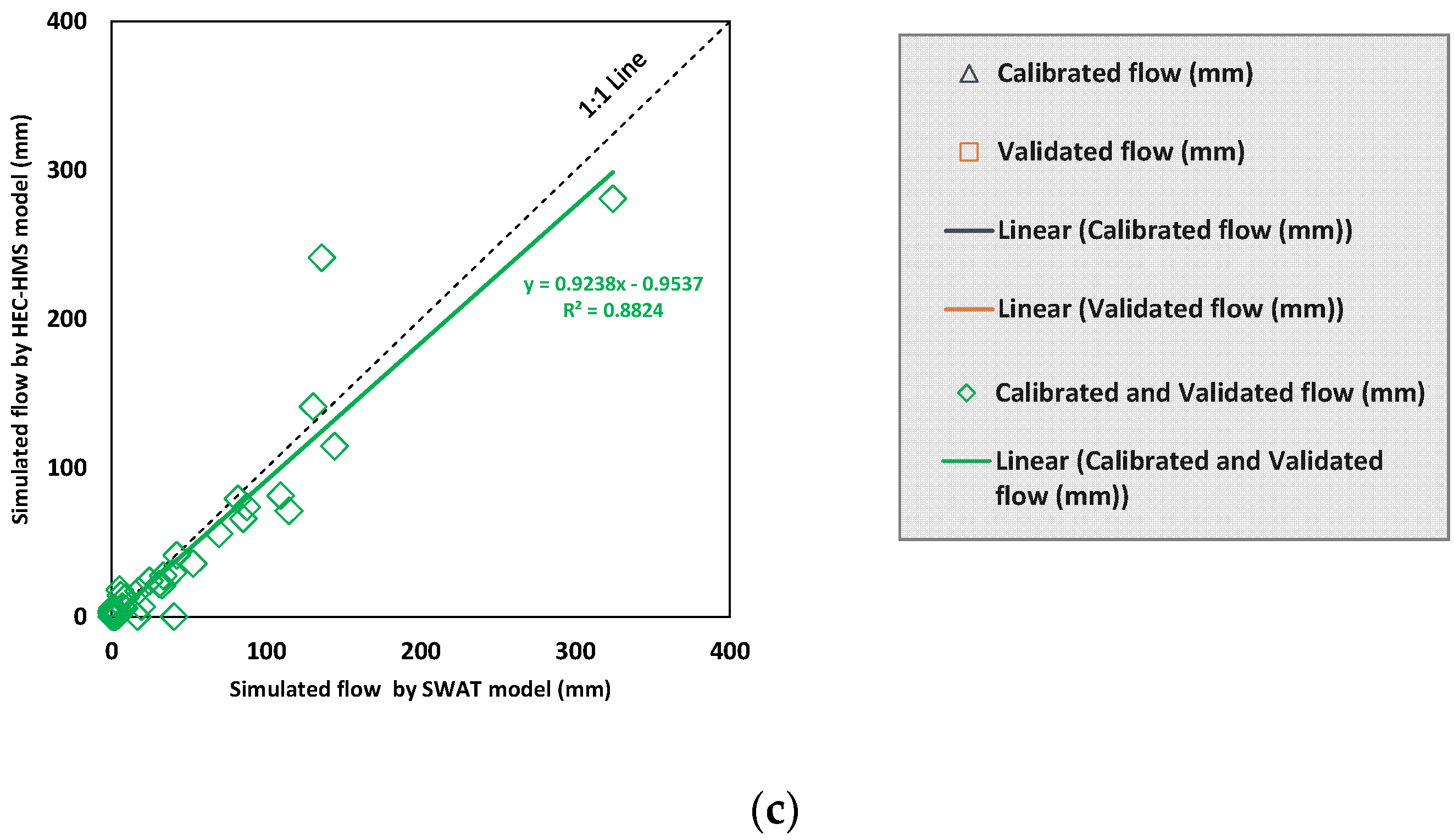
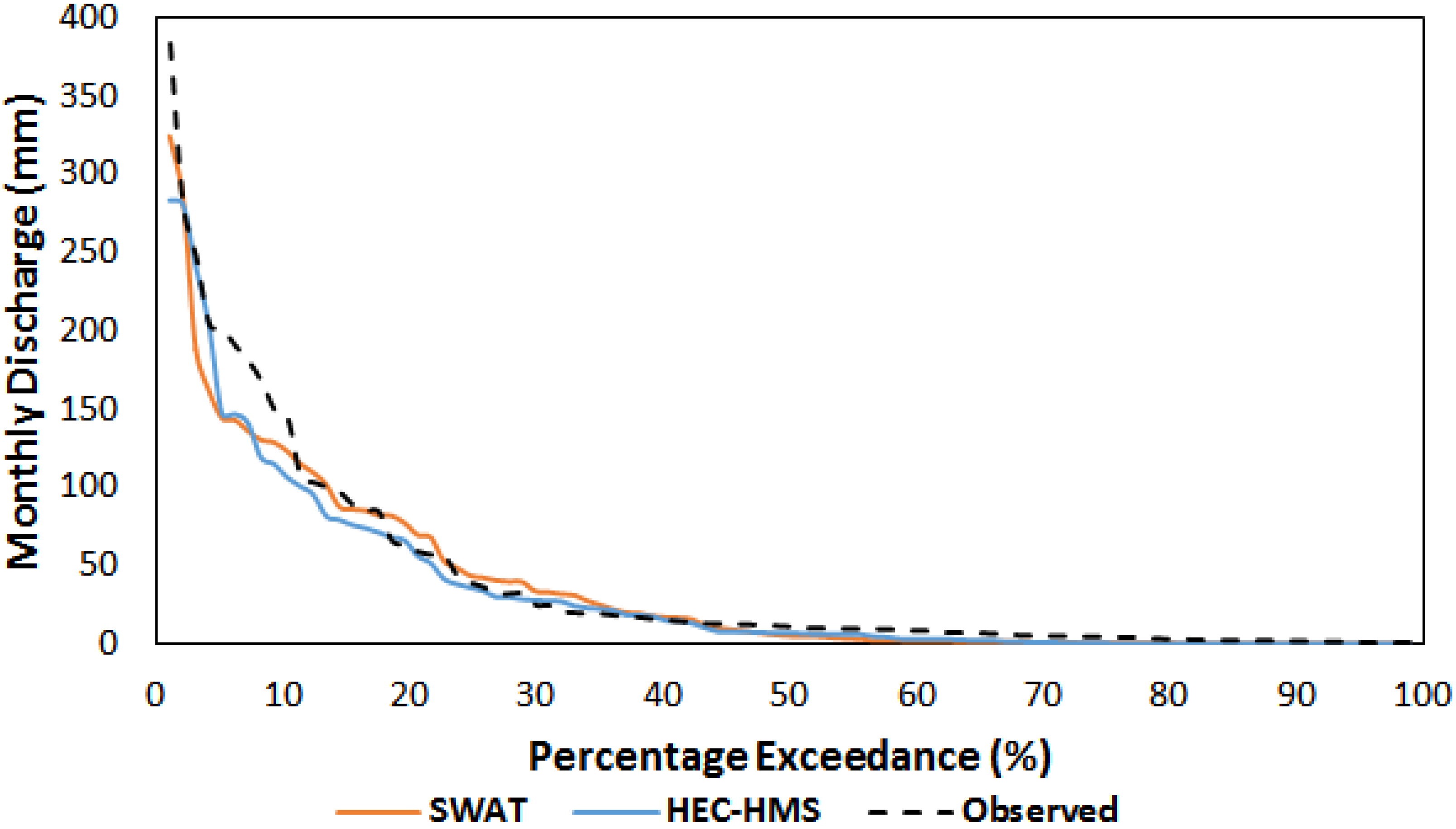
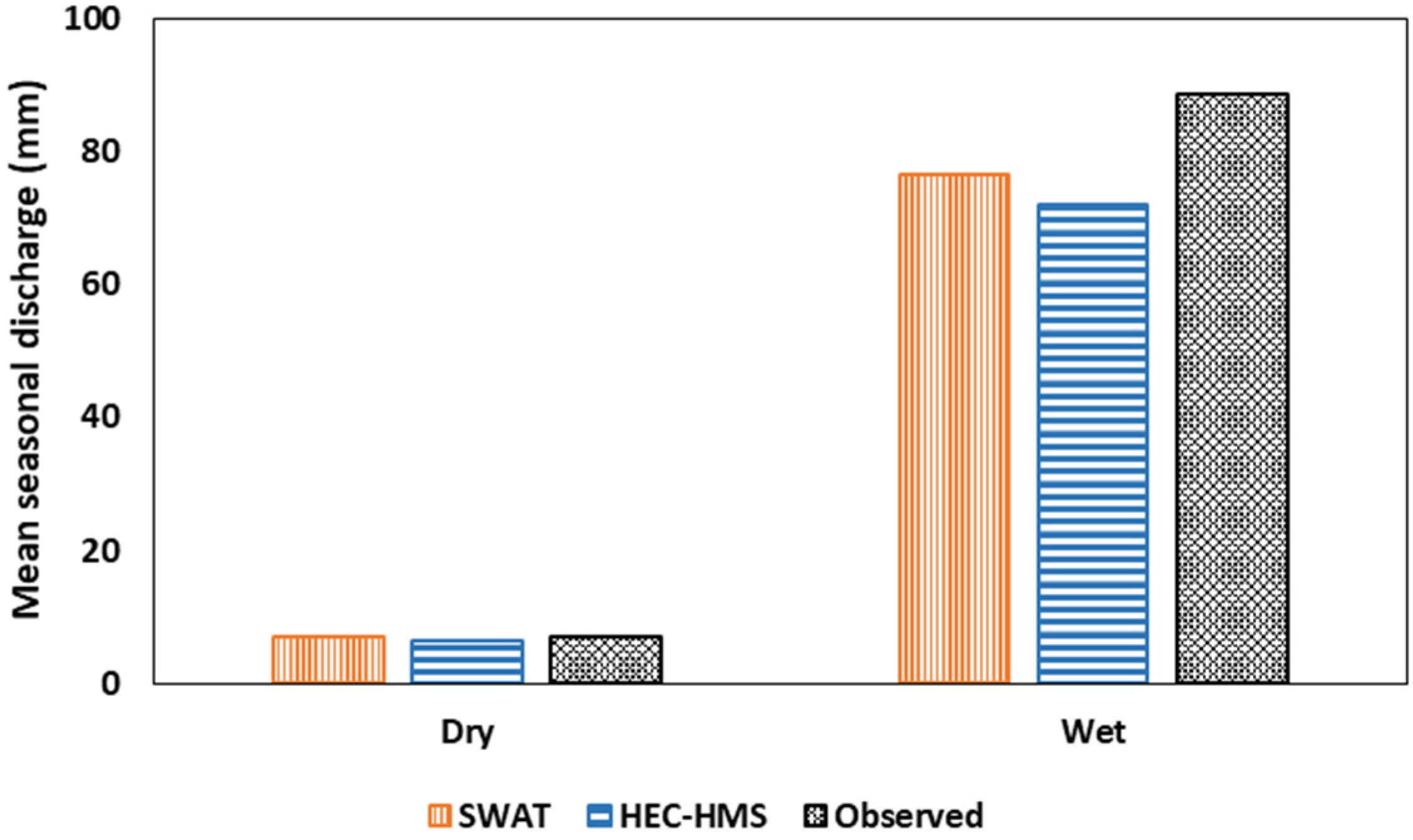
| Method | Parameter | Unit | Optimized Value |
|---|---|---|---|
| Soil Moisture Accounting | Soil Percentage | % | 70 |
| Groundwater 1 | % | 45 | |
| Groundwater 2 | % | 82 | |
| Max. Infiltration | mm/hr | 4.5 | |
| Impervious Percentage | % | 16.2 | |
| Soil Storage | mm | 276 | |
| Tension Storage | mm | 30 | |
| Soil Percolation | mm/hr | 0.42 | |
| GW 1 Storage | mm | 9 | |
| GW 1 Percolation | mm/hr | 0.675 | |
| GW 1 Coefficient | hr | 120 | |
| GW 2 Storage | mm | 100 | |
| GW 2 Percolation | mm/hr | 1 | |
| GW 2 Coefficient | hr | 100 | |
| Clark Unit Hydrograph | Time of Concentration | hr | 10 |
| Storage Coefficient | hr | 42 | |
| Recession | Initial Discharge | m3/s | 0.1 |
| Recession Constant | 0.35 | ||
| Ratio to Peak | 0.4 | ||
| Muskingum | K | hr | 0.02 |
| x | 0.3 |
| Cluster | Daily | Monthly | ||||||
|---|---|---|---|---|---|---|---|---|
| NOF | NSE | PBIAS | R2 | NOF | NSE | PBIAS | R2 | |
| Calibration (2007–2010) | 1.52 | 0.70 | −14.45 | 0.70 | 0.71 | 0.79 | −14.45 | 0.80 |
| Validation (2011–2014) | 1.58 | 0.60 | −16.63 | 0.55 | 0.80 | 0.82 | −16.63 | 0.84 |
Publisher’s Note: MDPI stays neutral with regard to jurisdictional claims in published maps and institutional affiliations. |
© 2022 by the authors. Licensee MDPI, Basel, Switzerland. This article is an open access article distributed under the terms and conditions of the Creative Commons Attribution (CC BY) license (https://creativecommons.org/licenses/by/4.0/).
Share and Cite
Chathuranika, I.M.; Gunathilake, M.B.; Baddewela, P.K.; Sachinthanie, E.; Babel, M.S.; Shrestha, S.; Jha, M.K.; Rathnayake, U.S. Comparison of Two Hydrological Models, HEC-HMS and SWAT in Runoff Estimation: Application to Huai Bang Sai Tropical Watershed, Thailand. Fluids 2022, 7, 267. https://doi.org/10.3390/fluids7080267
Chathuranika IM, Gunathilake MB, Baddewela PK, Sachinthanie E, Babel MS, Shrestha S, Jha MK, Rathnayake US. Comparison of Two Hydrological Models, HEC-HMS and SWAT in Runoff Estimation: Application to Huai Bang Sai Tropical Watershed, Thailand. Fluids. 2022; 7(8):267. https://doi.org/10.3390/fluids7080267
Chicago/Turabian StyleChathuranika, Imiya M., Miyuru B. Gunathilake, Pavithra K. Baddewela, Erandi Sachinthanie, Mukand S. Babel, Sangam Shrestha, Manoj K. Jha, and Upaka S. Rathnayake. 2022. "Comparison of Two Hydrological Models, HEC-HMS and SWAT in Runoff Estimation: Application to Huai Bang Sai Tropical Watershed, Thailand" Fluids 7, no. 8: 267. https://doi.org/10.3390/fluids7080267







